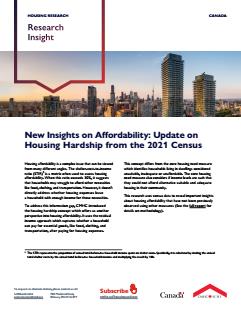This Research Insight highlights the limitations of the shelter-cost-to-income ratio (STIR) in assessing housing affordability, as it overlooks whether households have enough income for other essentials. CMHC introduced the housing hardship concept, using residual income to gauge financial strain after housing costs. Census data reveals subsidized renters faced higher hardship rates in 2021 than non-subsidized renters, despite lower shelter costs, with overall hardship rates declining from 2016 to 2021 due to temporary COVID-19 supports.
Key insights:
- Subsidized renters were much more likely to experience housing hardship despite lower shelter costs, with about half facing hardship in 2021 compared to 12.3% of non-subsidized renters.
- Lone-parent, female-led, Indigenous, racialized, and immigrant-led households were significantly more likely to face housing hardship compared to other demographic groups.
- Overall housing hardship rates declined from 2016 to 2021, partly due to temporary COVID-19 supports, though rates remained highest in the Northwest Territories and cities like Toronto and Vancouver.
- Author:
- CMHC
- Document Type:
- Date Published:
- November 19, 2024







 Share via Email
Share via Email
